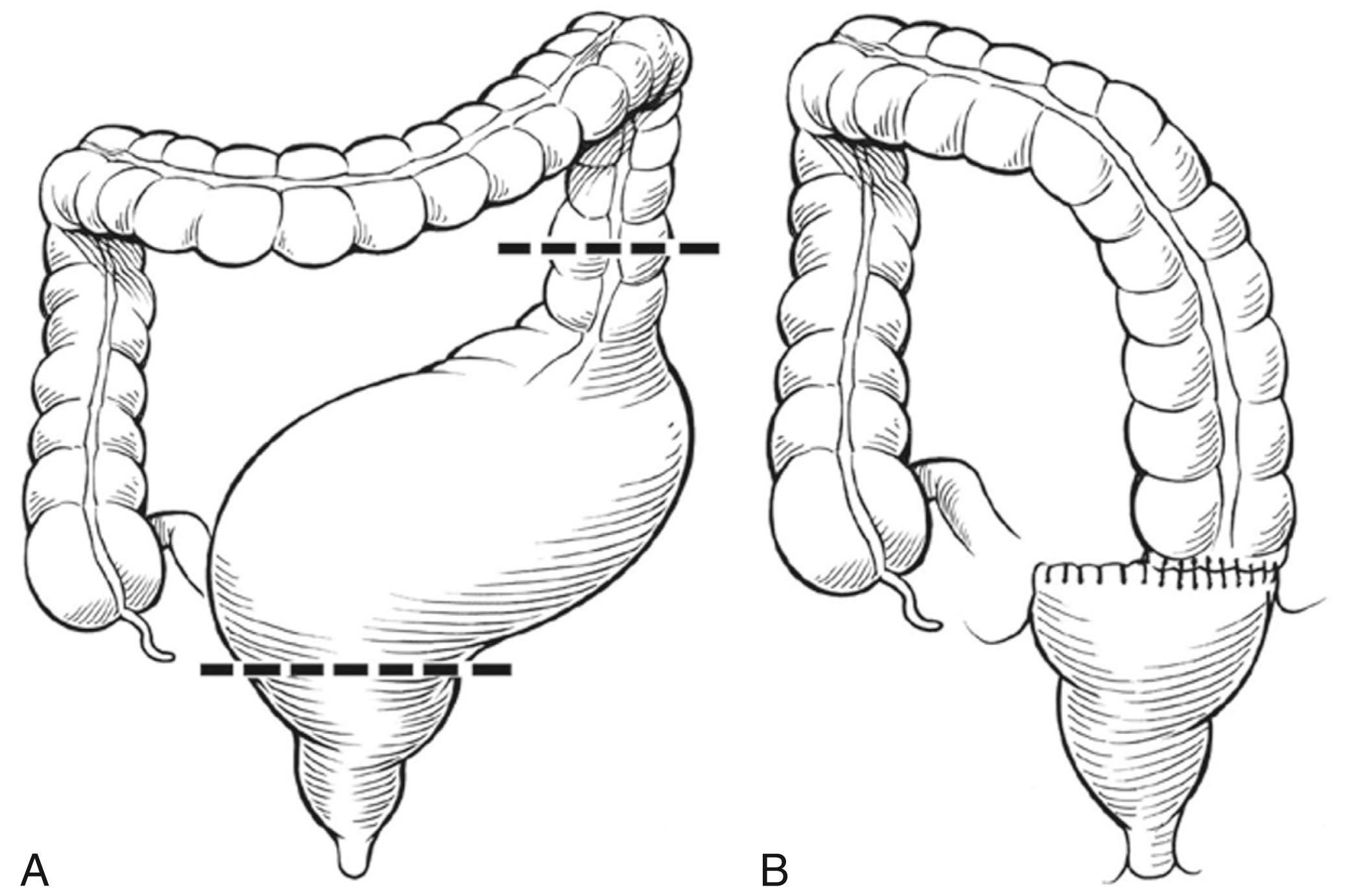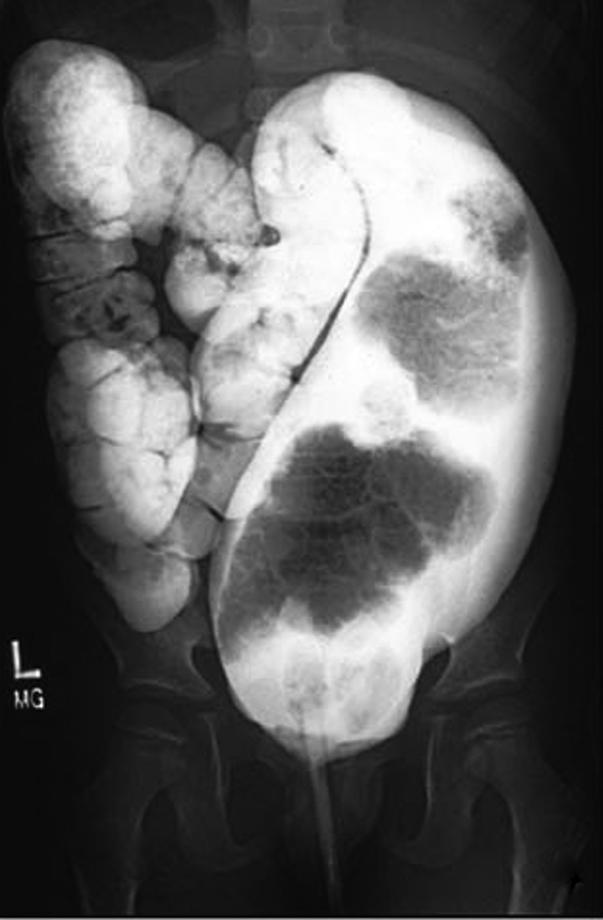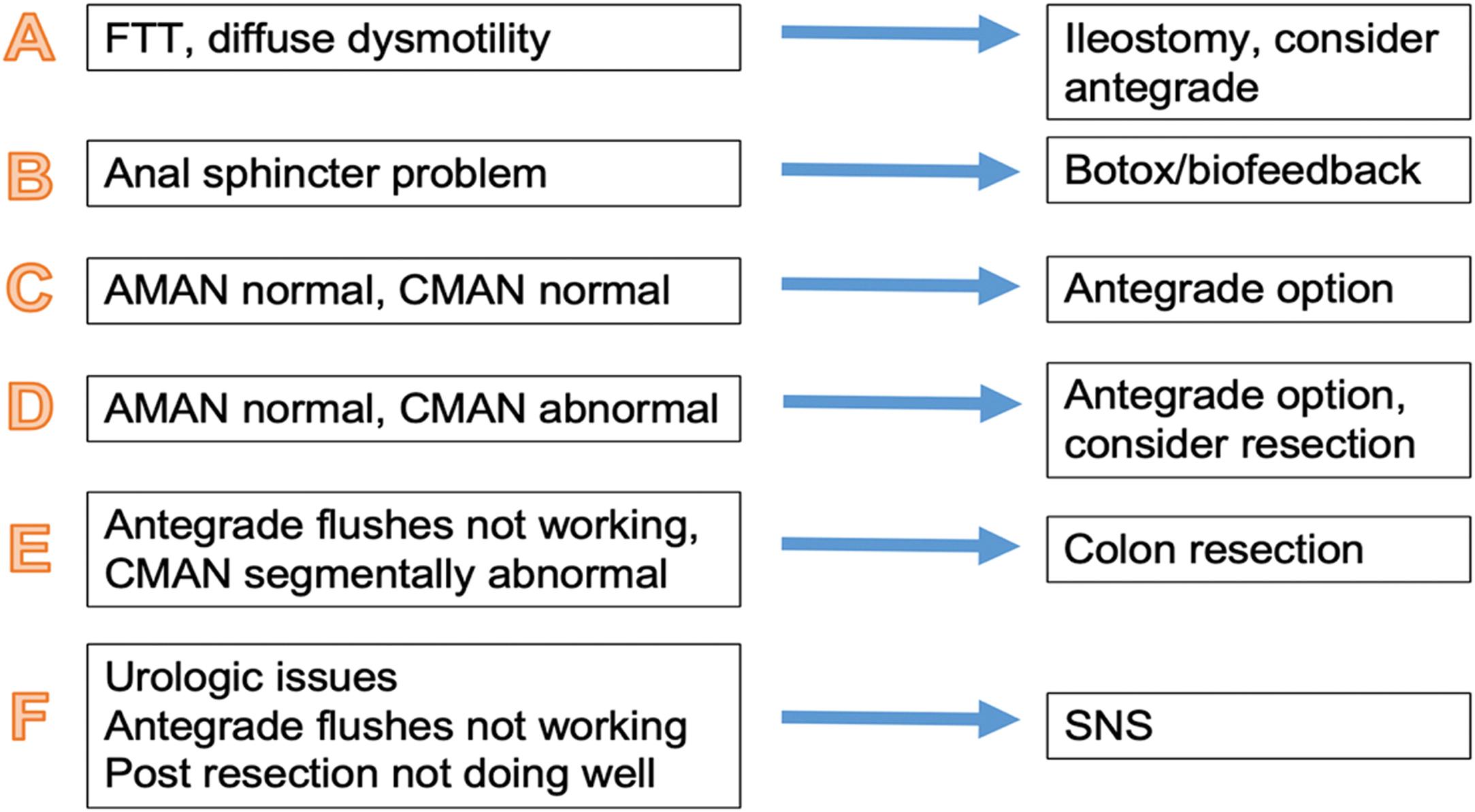Physical Address
304 North Cardinal St.
Dorchester Center, MA 02124
![]() Access the accompanying videos for this chapter online. Available on ExpertConsult.com .
Access the accompanying videos for this chapter online. Available on ExpertConsult.com .
Patients who present with the inability to have voluntary bowel movements include those born with anorectal malformations (ARMs), Hirschsprung disease (HD), spinal anomalies, or severe functional constipation. Some of these patients may present with severe constipation, which can cause overflow soiling, while others suffer from true fecal incontinence. Bowel management is a term that describes the medical and/or surgical management needed to control the retention and/or evacuation of stool, and the surgeon can play an important role in the care of these patients.
The distinction between soiling with potential for voluntary control and true incontinence affects the workup, medical management options, and operative approach, if needed. For example, in patients with a history of ARMs with overflow soiling, disimpaction, followed by an aggressive laxative regimen, often makes them continent (i.e., capable of having voluntary bowel movements). These children behave just like patients with severe functional constipation with soiling. In some of these patients, antegrade flushes and/or surgical resection of a dilated rectosigmoid can dramatically reduce or eliminate the daily laxative requirements and improve the child’s quality of life.
In contrast, patients with true fecal incontinence require a mechanical program with a daily enema, which allows them to be kept artificially clean. Treating them with laxatives will not work as they lack the physiologic mechanisms to control their stooling. For these patients, a surgical option that allows the daily enema to be administered antegrade is often helpful.
The clinician must understand the important anatomic considerations differentiating these two groups of children because their initial presentations can be quite similar (i.e., “soiling”), but the treatments and surgical options differ dramatically.
Patients with an ARM are evaluated based on their continence potential and current anatomy. Those with good continence potential in the setting of an ARM (i.e., well-developed spine, normal sacral ratio, and favorable prognosis type of malformation) can suffer from varying degrees of hypomotility and dilation of the rectum and sigmoid colon (megarectosigmoid), which may lead to soiling. This can occur after a technically correct original operation but without adequate postoperative laxative management. Evaluation of children with an ARM should include knowledge of the original ARM, the quality of their sacrum and spine, and the radiographic anatomy of their rectosigmoid colon via a contrast enema. Following this workup, it can be predicted whether the patient has the potential for voluntary bowel control. Those patients found to have complications from the original operation that have caused anatomic issues that preclude the development of voluntary bowel movements (anal mislocation, stricture, or rectal prolapse) will benefit from a reoperation to maximize their continence potential.
Patients belonging to the “good prognosis” group are treated with laxatives once their colon is clean. A clean colon can be achieved with rectal enemas or an oral bowel cleanout. Once the colon is radiographically clean, the constipation is treated with large doses of stimulant laxatives (not stool softeners). The laxative doses are titrated to an amount that completely evacuates the colon radiographically. The addition of water-soluble fiber is key to provide some bulk to the stool. The goal is to try to achieve a good bowel movement pattern with one to two well-formed stools per day. If it becomes evident that the child is capable of having voluntary bowel movements and is actually continent, then the explanation for their soiling was overflow. If the process of fecal impaction and overflow soiling has progressed for years, treatment may be difficult because the child may have developed a megasigmoid colon, requiring an enormous amount of laxatives to empty it. In this case, resection of the dilated sigmoid ( Fig 11-1A ) may be appropriate. In such patients, it is vital to preserve the distal rectum, which acts as a reservoir and provides for the sensation of rectal fullness (i.e., proprioception) ( Fig. 11-1B ), helping with continence. Because the anal sphincters and anal canal failed to develop normally, the distal rectum may be the key to maintaining adequate holding and then propulsion of the stool. During the sigmoid resection in this specific patient group, the surgeon must be very cognizant of the colonic blood supply. The arcade to the distal pull-through may have been disrupted by the initial colostomy, and the hemorrhoidal vessels may have been lost during the rectal dissection. An internal mesentric artery branch must be preserved to the distal rectum during the sigmoid resection.

Patients belonging to the “poor prognosis” potential group, those who have been on a successful enema regimen who wish to administer it themselves, or those taking laxatives (who seek a more reliably timed colonic emptying) may all be candidates for antegrade enemas via a Malone appendicostomy. Evaluation of the patient’s urinary status is important prior to utilizing the appendix for the Malone as the appendix can be split to create both a Malone and Mitrofanoff simultaneously. For this reason, Malone channel creation is often delayed until after 4 years of age in children with an ARM.
The preoperative evaluation and preparation of the patient undergoing a laparoscopic operation are the same as those required for the comparable open operation. A patient who is undergoing an elective colonic procedure and needs preoperative bowel preparation can be admitted before the operation for this purpose if needed.
Children born with HD and with postoperative bowel management problems require a systematic approach to evaluation. They fall into one of two categories: soiling/incontinence or constipation/obstruction. Evaluation for the explanation as to why a child is not doing well after the corrective operation should include a contrast enema and examination of the pull-through under anesthesia. Those who do not have a preserved anal canal or intact sphincters (which can be lost or injured if the original pull-through was started too low or the anal canal overstretched) may require a daily enema to stay clean and could benefit from a Malone appendicostomy. Children with intact sphincter mechanisms but the inability to have voluntary bowel movements due to behavioral reasons may retain an antegrade flush, and for them, botulinum toxin (Botox) injection into the anal canal may be helpful.
Functional constipation is a clinical diagnosis, and the Rome III criteria are widely accepted and utilized in infants and children up to 4 years of age. These criteria include 1 month of at least two of the following: two or fewer defecations per week, at least one episode per week of incontinence after acquiring toileting skills, a history of excessive stool retention, a history of painful or hard bowel movements, the presence of a large fecal mass in the rectum, or a history of large-diameter stools that may obstruct the toilet. Accompanying symptoms include irritability with decreased appetite and/or early satiety. These accompanying symptoms disappear immediately following passage of a large stool.
Greater than 90% of children with functional constipation are treated successfully with a combination of behavioral modifications, diet, and medical management. A subset of patients who do not respond to conventional therapy are termed “failure of medical management” and often sent by a pediatrician or gastroenterologist for surgical intervention. These patients do not empty their colon or continue soiling despite treatment with laxatives or enemas.
Functional constipation is a common and self-perpetuating condition that, if inadequately treated, allows for only partial emptying of the colon, leading to the accumulation of larger and larger amounts of stool in the rectosigmoid colon, which ultimately creates a megasigmoid colon. The result is soiling. On a water-soluble contrast enema, the characteristic image is a megarectosigmoid colon with dilation of the colon all the way down to the level of the levator mechanism with sigmoid redundancy ( Fig. 11-2 ), in contrast to what is seen in HD patients. This condition is manageable but not curable, and it requires careful lifelong follow-up, with recurrent problems developing if treatments are tapered off. At this point, an intense bowel management program should be employed. During bowel management, the laxative medication is adjusted while radiographically documenting colonic emptying, and the patient’s reported symptoms are collected.

Once a patient has failed medical management, colonic motility studies are important. These can include a sitz marker transit study, nuclear scintigraphy, and colonic manometry (CMAN). Anorectal manometry is also vital to assess the anal spincters. These dysmotility cases usually fall into one of the following categories and examples:
A 2-year-old child presents with continued abdominal distension, dietary intolerance, failure to thrive, and diffuse colonic dysmotility.
Comment: Patients younger than 3 years old with diffuse colonic dysmotility and failure to thrive need an ileostomy with repeat colonic motility testing at 1-year intervals, at which point one of the following options can be explored versus a more extensive surgical resection of the colon if the motility fails to improve.
A 5-year-old male presents with constipation and internal sphincter achalasia on AMAN.
Comment: Those with internal or external sphincter achalasia/dyssynergia (or pelvic floor dysfunction) benefit from anal Botox injection or biofeedback.
A 5-year-old female presents with constipation and impaction without soiling. AMAN and CMAN are both normal.
Comment: Patients with constipation and fecal impaction without soiling can benefit from a laparoscopic antegrade continence enema.
A 6-year-old male presents with constipation and fecal soiling. Testing demonstrates normal AMAN, but CMAN demonstrates a segmental abnormality, usually loss of high-amplitude contractions in the sigmoid colon.
Comment: For constipation with fecal impaction and soiling, laparoscopic colonic resection with Malone appendicostomy can be helpful, with the aim to reduce the time of flushes and laxatives in the future at a reduced dose. A trial of antegrade flushes only in this group often works and may preclude the need for the colon resection.
An 8-year-old female with a previously placed Malone appendicostomy is not emptying her antegrade flushes and repeat CMAN testing demonstrates segmentally abnormal colon motility.
Comment: Antegrade flushes are not working, and there is a segment that is dysmotile (often the sigmoid colon). A laparoscopic or laparoscopic-assisted sigmoid resection is indicated.
A 9-year-old male with urinary incontinence and previous colon resection for a dysmotile sigmoid colon continues to have issues with the antegrade flush not working well.
Comment: Failure of antegrade rectal enemas or failure following colonic resection and antegrade flushes needs repeat colonic manometry. Further colonic resection can be considered and/or a sacral nerve stimulator can be placed ( Fig. 11-3 ), which may also improve the urinary dysmotility.

Become a Clinical Tree membership for Full access and enjoy Unlimited articles
If you are a member. Log in here